
|
시장보고서
상품코드
1374894
아시아태평양의 UAV 추진 시스템 시장(2023-2033년)Asia-Pacific UAV Propulsion System Market - Analysis and Forecast, 2023-2033 |
||||||
아시아태평양의 UAV 추진 시스템 시장 규모는 2022년 16억 7,210만 달러에서 예측 기간 동안 2.35%의 CAGR을 기록하며 2033년에는 21억 5,700만 달러 규모로 성장할 것으로 예상됩니다.
이 시장은 주로 국방 및 정부 분야에서 활용되면서 큰 폭으로 증가할 것으로 예상됩니다. 한편, 예측 기간 동안 상업 부문도 크게 성장할 것으로 예상됩니다. 이러한 성장은 많은 민간 기업에서 UAV에 대한 수요가 증가하고 있으며, 이는 첨단 추진 시스템에 대한 투자를 촉진하고 있습니다.
무인항공기(UAV)는 전 세계적으로 중요한 R&D의 대상이 되어 왔으며, 초기에는 군사적 용도로만 사용되던 UAV 시장은 과학 기술의 발전과 함께 센서, 카메라, 광검출, 거리측정(LiDAR)과 같은 다양한 모듈을 포함하면서 상업 및 민수 분야로 확대되고 있습니다.
아시아태평양의 UAV 추진 시스템 시장을 조사했으며, 시장 개요, 시장 성장에 영향을 미치는 각종 영향요인 분석, 규제 환경, 시장 규모 추이 및 예측, 각종 부문별·주요 국가별 상세 분석, 경쟁 구도, 주요 기업 분석 등의 정보를 정리하여 전해드립니다.
아시아태평양의 UAV 추진 시스템 시장 : 소개
| 주요 시장 통계 | |
|---|---|
| 예측 기간 | 2023-2033년 |
| 2023년 평가 | 17억 980만 달러 |
| 2033년 전망 | 21억 5,700만 달러 |
| CAGR | 2.35% |
시장 구분:
세분화 1: UAV 유형별
- 소형 UAV
- 소형 UAV
- 초소형 UAV
- 전술적 UAV
- 중고도 장기 내구형(MALE)
- 고고도 장기 내구형(HALE)
- 수직 이착륙(VTOL)
세분화 2: 최종사용자별
- 상업용
- 군사용
- 정부용
세분화 3: 엔진 마력별
- 10-50 HP
- 51-100 HP
- 101-150 HP
- 151-200 HP
- 200 HP 이상
세분화 4: 엔진 종류별
- 피스톤 엔진
- 터빈 엔진
- 터보팬 엔진
- 전기 엔진
- 완켈 엔진
- 태양열 엔진
세분화 5: 지역별
- 아시아태평양 : 중국, 인도, 일본, 기타
목차
제1장 시장
- 업계 전망
- UAV 추진 시스템 시장 : 개요
- UAV 운영의 전동 솔루션에서 IC 엔진 솔루션으로의 이동
- UAV용 IC 엔진 관련 신기술 동향
- IC 엔진 솔루션과 호환성 있는 주요 UAV 이용 사례
- UAV에 탑재된 주요 IC 엔진의 비교 평가
- UAV 추진 시스의템 진행중 및 향후 프로그램
- UAV 추진 시스템의 주요 공급업체
- 스타트업과 투자 상황
- 공급망 분석
제2장 지역
- 세계의 UAV 추진 시스템 시장 : 지역별
- 아시아태평양
- 시장
- 용도
- 제품
- 아시아태평양 : 국가별
제3장 시장 : 경쟁 벤치마킹과 기업 개요
- 시장 점유율 분석
- Gemini Diesel(Superior Aviation Group)
- PBS India(PBS Aerospace)
제4장 성장 기회와 추천사항
- 성장 기회
- 전기 추진에서 IC 엔진 추진으로의 이동
- 비용 효율적인 제조 기술의 개발
제5장 조사 방법
ksm 23.11.16“The APAC UAV Propulsion System Market expected to reach $2,157.0 million by 2033.”
Introduction to Asia-Pacific UAV Propulsion System Market
| KEY MARKET STATISTICS | |
|---|---|
| Forecast Period | 2023 - 2033 |
| 2023 Evaluation | $1,709.8 Million |
| 2033 Forecast | $2,157.0 Million |
| CAGR | 2.35% |
The Asia-Pacific UAV propulsion system market is projected to reach $2,157.0 million by 2033 from $1,672.1 million in 2022, growing at a CAGR of 2.35% during the forecast period 2023-2033.
The market for UAV propulsion systems in Asia-Pacific is anticipated to increase significantly, primarily due to applications in the defense and government sectors. The substantial financial investment required to develop propulsion systems explains this. Nonetheless, there is a significant chance for growth in commercial applications during the anticipated period of time. This expansion is driven by the increased demand for UAVs across many commercial businesses, which has prompted investments in state-of-the-art propulsion systems.
Market Introduction
Since its invention in the early 19th century, unmanned aerial vehicles (UAVs) have been the subject of significant worldwide research and development initiatives. The market for UAVs was first dominated by military uses. But as science and technology have progressed, UAVs have expanded to include a range of modules, such as sensors, cameras, and light detection and ranging (LiDAR), increasing their usefulness in both the commercial and civil sectors.
These developments have forced industry participants to emphasize UAV propulsion system development while also increasing UAV manufacturing. UAVs can benefit from conventional fuel propulsion systems' large cargo capacity, long flight times, wide operational range, and quick resupply. However, there are still issues facing the aviation industry due to the limited supply of fossil fuels and growing worries about their effects on the environment.
As a result of funding from UAV manufacturers, research and development efforts have increased dramatically, concentrating on solar-powered and hybrid/all-electric UAVs. For those involved in the market, these advances offer profitable prospects. The market's expansion is nevertheless constrained by things like governmental laws and the high cost of production.
A rise in commercial applications has also led to growth in the apac market for UAV propulsion systems. In an effort to attract more clients, private enterprises are expanding the range of UAV services they offer by implementing cutting-edge and effective propulsion technologies. Research institutes are a noteworthy user sector that contributes significantly to the growth of the market by actively participating in the design, development, and testing of the newest UAVs and related propulsion systems.
Because of these benefits, businesses are constantly trying to innovate their offerings. They are working with UAV makers and service providers to test and develop propulsion systems, which is creating a dynamic environment of advancement and potential in the industry.
Market Segmentation:
Segmentation 1: by UAV Type
- Small UAVs
- Mini UAVs
- Micro UAVs
- Tactical UAVs
- Medium-Altitude Long-Endurance (MALE)
- High-Altitude Long-Endurance (HALE)
- Vertical Take-off and Landing (VTOL)
Segmentation 2: by End User
- Commercial
- Military
- Civil government
Segmentation 3: by Engine Horsepower
- 10-50 HP
- 51-100 HP
- 101-150 HP
- 151-200 HP
- Above 200 HP
Segmentation 4: by Engine Type
- Piston Engine
- Turbine Engine
- Turbofan Engine
- Electrically Powered Engine
- Wankel Engine
- Solar-Powered Engine
Segmentation 5: by Region
- Asia-Pacific - China, India, Japan, and Rest-of-Asia-Pacific
Key Drivers for Asia Pacific UAV Propulsion System Market
The growing need for UAVs for military applications and the region's growing defense and security requirements are the main factors driving the Asia-Pacific (APAC) UAV propulsion system market. Simultaneously, the growing array of industrial uses, including aerial photography, infrastructure inspection, and agricultural, is encouraging the uptake of sophisticated propulsion systems. Innovation is being fueled by technological breakthroughs, especially in eco-friendly and more efficient engines, and the rise of the UAV sector is being supported by government programs and regulations. Research & development expenditures along with technology partnerships are driving the creation of innovative propulsion systems specifically suited to the APAC market. Moreover, the development of propulsion systems appropriate for a broad range of space-related applications is being aided by the APAC region's interest in satellite deployment and space exploration.
How can this report add value to an organization?
Product/Innovation Strategy: The service segment helps the reader understand the different end users that will generate the demand for UAV propulsion systems in APAC. Moreover, the study provides the reader with a detailed understanding of the different UAV propulsion systems based on UAV type (small UAVs, tactical UAVs, MALE, HALE, and VTOL), end user (commercial, military, and civil government), engine horsepower (10-50 HP, 51-100 HP, 101-150 HP, 151-200 HP, and Above 200 HP), and engine type (piston engine, turbine engine, turbofan, Wankel engine, electrically powered engine, and solar-powered engine).
Growth/Marketing Strategy: Key competitors in the market have made significant developments in the Asia-Pacific (APAC) UAV propulsion system market through company expansion initiatives, contracts, product launches, mergers, partnerships, collaborations, and joint ventures. The companies have committed to strengthen their position in the APAC UAV propulsion systems market, which is their preferred strategy.
Competitive Strategy: Key players in the Asia Pacific UAV propulsion systems market analyzed and profiled in the study involve UAV propulsion system manufacturers. Moreover, a detailed competitive benchmarking of the players operating in the Asia Pacific UAV propulsion system market has been done to help the reader understand how players stack against each other, presenting a clear market landscape. Additionally, comprehensive competitive strategies such as contracts, partnerships, agreements, acquisitions, and collaborations will aid the reader in understanding the untapped revenue pockets in the market.
Table of Contents
1 Markets
- 1.1 Industry Outlook
- 1.1.1 UAV Propulsion System Market: Overview
- 1.1.2 Migration of UAV Operations from Electric to IC Engine Solutions
- 1.1.3 Emerging Technology Trends Related to IC Engines for UAV
- 1.1.4 Key UAV Use-Cases Compatible with IC Engine Solutions
- 1.1.5 Comparative Assessment of Key IC Engines Deployed in UAV
- 1.1.6 Ongoing and Upcoming programs for UAV Propulsion Systems
- 1.1.7 Key Supplier for UAV Propulsion System
- 1.1.8 Start-Ups and Investment Landscape
- 1.1.9 Supply Chain Analysis
2 Region
- 2.1 Global UAV Propulsion System Market (by Region)
- 2.2 Asia-Pacific
- 2.2.1 Markets
- 2.2.1.1 Key Players in Asia-Pacific
- 2.2.1.2 Business Drivers
- 2.2.1.3 Business Challenges
- 2.2.2 Application
- 2.2.2.1 Asia-Pacific UAV Propulsion System Market (by UAV Type), Volume and Value
- 2.2.2.2 Asia-Pacific UAV Propulsion System Market (by End User), Volume and Value
- 2.2.3 Product
- 2.2.3.1 Asia-Pacific UAV Propulsion System Market (by Engine Horsepower), Volume and Value
- 2.2.3.2 Asia-Pacific UAV Propulsion System Market (by Engine Type), Volume and Value
- 2.2.4 Asia-Pacific (by Country)
- 2.2.4.1 China
- 2.2.4.1.1 Markets
- 2.2.4.1.1.1 Key Players in China
- 2.2.4.1.2 Application
- 2.2.4.1.2.1 China UAV Propulsion System Market (by UAV Type), Volume and Value
- 2.2.4.1.2.2 China UAV Propulsion System Market (by End User), Volume and Value
- 2.2.4.1.3 Product
- 2.2.4.1.3.1 China UAV Propulsion System Market (by Engine Horsepower), Volume and Value
- 2.2.4.1.3.2 China UAV Propulsion System Market (by Engine Type), Volume and Value
- 2.2.4.1.1 Markets
- 2.2.4.2 India
- 2.2.4.2.1 Markets
- 2.2.4.2.1.1 Key Players in India
- 2.2.4.2.2 Application
- 2.2.4.2.2.1 India UAV Propulsion System Market (by UAV Type), Volume and Value
- 2.2.4.2.2.2 India UAV Propulsion System Market (by End User), Volume and Value
- 2.2.4.2.3 Product
- 2.2.4.2.3.1 India UAV Propulsion System Market (by Engine Horsepower), Volume and Value
- 2.2.4.2.3.2 India UAV Propulsion System Market (by Engine Type), Volume and Value
- 2.2.4.2.1 Markets
- 2.2.4.3 Japan
- 2.2.4.3.1 Markets
- 2.2.4.3.1.1 Key Players in Japan
- 2.2.4.3.2 Application
- 2.2.4.3.2.1 Japan UAV Propulsion System Market (by UAV Type), Volume and Value
- 2.2.4.3.2.2 Japan UAV Propulsion System Market (by End User), Volume and Value
- 2.2.4.3.3 Product
- 2.2.4.3.3.1 Japan UAV Propulsion System Market (by Engine Horsepower), Volume and Value
- 2.2.4.3.3.2 Japan UAV Propulsion System Market (by Engine Type), Volume and Value
- 2.2.4.3.1 Markets
- 2.2.4.4 Rest-of-Asia-Pacific
- 2.2.4.4.1 Markets
- 2.2.4.4.1.1 Key Players in Rest-of-Asia-Pacific
- 2.2.4.4.2 Application
- 2.2.4.4.2.1 Rest-of-Asia-Pacific UAV Propulsion System Market (by UAV Type), Volume and Value
- 2.2.4.4.2.2 Rest-of-Asia-Pacific UAV Propulsion System Market (by End User), Volume and Value
- 2.2.4.4.3 Product
- 2.2.4.4.3.1 Rest-of-Asia-Pacific UAV Propulsion System Market (by Engine Horsepower), Volume and Value
- 2.2.4.4.3.2 Rest-of-Asia-Pacific UAV Propulsion System Market (by Engine Type), Volume and Value
- 2.2.4.4.1 Markets
- 2.2.4.1 China
- 2.2.1 Markets
3 Markets - Competitive Benchmarking & Company Profiles
- 3.1 Market Share Analysis
- 3.2 Gemini Diesel (Superior Aviation Group)
- 3.2.1 Company Overview
- 3.2.1.1 Role of Gemini Diesel (Superior Aviation Group) in the Global UAV Propulsion System Market
- 3.2.1.2 Product Portfolio
- 3.2.2 Corporate Strategies
- 3.2.2.1 Partnerships, Collaborations, Agreements, Contracts, Mergers and Acquisitions
- 3.2.3 Analyst View
- 3.2.1 Company Overview
- 3.3 PBS India (Part of PBS Aerospace)
- 3.3.1 Company Overview
- 3.3.1.1 Role of PBS India (Part of PBS Aerospace) in the Global UAV Propulsion System Market
- 3.3.1.2 Product Portfolio
- 3.3.2 Business Strategies
- 3.3.2.1 New Product Developments and Fundings
- 3.3.3 Analyst View
- 3.3.4 Sample Company
- 3.3.4.1 Overview
- 3.3.4.2 Top Products / Product Portfolio
- 3.3.4.3 Top Competitors
- 3.3.4.4 Target Customers
- 3.3.4.5 Key Personnel
- 3.3.4.6 Analyst View
- 3.3.4.7 Market Share
- 3.3.5 Sample Company
- 3.3.5.1 Overview
- 3.3.5.2 Top Products / Product Portfolio
- 3.3.5.3 Top Competitors
- 3.3.5.4 Target Customers
- 3.3.5.5 Key Personnel
- 3.3.5.6 Analyst View
- 3.3.5.7 Market Share
- 3.3.6 Sample Company
- 3.3.6.1 Overview
- 3.3.6.2 Top Products / Product Portfolio
- 3.3.6.3 Top Competitors
- 3.3.6.4 Target Customers
- 3.3.6.5 Key Personnel
- 3.3.6.6 Analyst View
- 3.3.6.7 Market Share
- 3.3.7 Sample Company
- 3.3.7.1 Overview
- 3.3.7.2 Top Products / Product Portfolio
- 3.3.7.3 Top Competitors
- 3.3.7.4 Target Customers
- 3.3.7.5 Key Personnel
- 3.3.7.6 Analyst View
- 3.3.7.7 Market Share
- 3.3.8 Sample Company
- 3.3.8.1 Overview
- 3.3.8.2 Top Products / Product Portfolio
- 3.3.8.3 Top Competitors
- 3.3.8.4 Target Customers
- 3.3.8.5 Key Personnel
- 3.3.8.6 Analyst View
- 3.3.8.7 Market Share
- 3.3.9 Sample Company
- 3.3.9.1 Overview
- 3.3.9.2 Top Products / Product Portfolio
- 3.3.9.3 Top Competitors
- 3.3.9.4 Target Customers
- 3.3.9.5 Key Personnel
- 3.3.9.6 Analyst View
- 3.3.9.7 Market Share
- 3.3.10 Sample Company
- 3.3.10.1 Overview
- 3.3.10.2 Top Products / Product Portfolio
- 3.3.10.3 Top Competitors
- 3.3.10.4 Target Customers
- 3.3.10.5 Key Personnel
- 3.3.10.6 Analyst View
- 3.3.10.7 Market Share
- 3.3.11 Sample Company
- 3.3.11.1 Overview
- 3.3.11.2 Top Products / Product Portfolio
- 3.3.11.3 Top Competitors
- 3.3.11.4 Target Customers
- 3.3.11.5 Key Personnel
- 3.3.11.6 Analyst View
- 3.3.11.7 Market Share
- 3.3.12 Sample Company
- 3.3.12.1 Overview
- 3.3.12.2 Top Products / Product Portfolio
- 3.3.12.3 Top Competitors
- 3.3.12.4 Target Customers
- 3.3.12.5 Key Personnel
- 3.3.12.6 Analyst View
- 3.3.12.7 Market Share
- 3.3.1 Company Overview
4 Growth Opportunities and Recommendation
- 4.1 Growth Opportunities
- 4.1.1 Transition from Electric to IC Engine Propulsion
- 4.1.1.1 Growth Opportunity 1: Development of Smaller IC Engines
- 4.1.1.2 Recommendations for UAV Propulsion System Manufacturers
- 4.1.1.3 Recommendations for UAV Manufacturers
- 4.1.2 Development of Cost-Effective Manufacturing Techniques
- 4.1.2.1 Growth Opportunity 2: Metal 3D Printing of Engine and Associated Components
- 4.1.2.2 Recommendations for UAV Propulsion System Manufacturers
- 4.1.2.3 Recommendations for UAV Manufacturers
- 4.1.1 Transition from Electric to IC Engine Propulsion
5 Research Methodology
- 5.1 Factors for Data Prediction and Modeling













